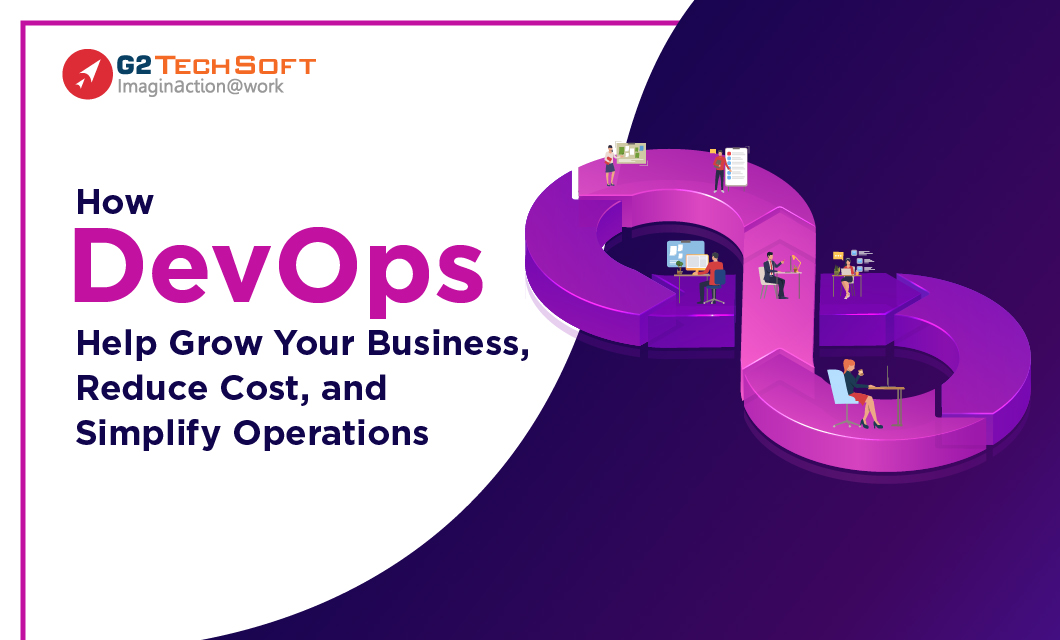
How DevOps Help Grow Your Business, Reduce Cost, and Simplify Operations
If your organization is not using DevOps management tools, here are three prime reasons why you should –
- Its business process automation services increase efficiency
- It offers agile, flexible business process management solutions that reduce redundancy and
- It helps decrease costs, most definitely. Well, DevOps infrastructure essentially sums up to this, but we have quite a lot in store for you.
Through this blog, you will understand why DevOps project management tools are a popular demand amongst IT organizations, besides how DevOps is helping to grow businesses.
DevOps and Infrastructure: How It Improves Business and Management Process
The current market is very unpredictable. Flexible, adaptable, and agile are a few development approaches that IT organizations must persistently follow to work alongside changing things. Software development is the word that best describes DevOps practice. In DevOps, business process management, development, and operation teams work together to design, develop, implement, and test software systems and applications rapidly. Agile
All best process management software, cloud software development and infrastructure, IT business process management systems, and manufacturing process management software applications are all made via the DevOps approach. It is because the DevOps model delivers more tangible results. It boosts the work process and team efficiency, speeds up feature implementation, optimizes products quickly, and delivers system applications with fewer errors.
Few Facts about DevOps Process Model:
Due to this unforeseen crisis, COVID-19 pandemic, organizations are forced to reduce their IT infrastructure and development costs. Many IT companies are looking for effective and affordable ways to do so.
DevOps models can help IT companies and other enterprises optimize their software application development, implementation, and maintenance. It is possible with the increasing number of cloud computing solutions.
In a nutshell, DevOps process:
- The model was established in an attempt to streamline organizations’ structure and make software development cost-effective, dynamic, flexible, and less time-consuming.
- It is a cross-functional approach.
- It combines two essential software development process parts, namely development and infrastructure
- DevOps provide mobility and flexibility by allowing organizations to analyze the market and its customers’ behavior from different standpoints and quickly address them.
How DevOps Help Organizations Optimize Costs
DevOps practices enable organizations to gain a clearer insight into the entire development life cycle, such as the kind and type of resources required to be used, the areas that need optimization and how, ways to control IT costs expenditure, and new solutions that help reduce cost and boost infrastructure usage.
Automates Infrastructure and CI/CD Process
By automating the IT infrastructure CI/CD process, manually controlling operating systems, servers, storage, database, and other infrastructural components, every time a new application is developed, it is reduced to zero. This enables developers to focus on value-yielding tasks. DevOps experts can help firms achieve this by determining the requirements, threats, risks, and opportunities through a complete infrastructural audit and planning.
After that, a road map is established, and solution architecture is formed that not only allows potential scaling but also stays compatible with automation and laaC.
Additionally, the DevOps team gets the core infrastructure ready for support management, like logging, monitoring, pipelines, and delivery. Once the infrastructure is ready, it is integrated with the services immediately with a pipeline configuration.
Use of Third-Party Services and Tools
Organizations can reduce operational overhead costs by leveraging third-party services, such as Google Cloud, AWS, and Azure. For instance, building a managed database service from scratch that comprises great features like regional setup, reliability, resilience, monitoring, and scalability, may take a lot of time and money.
However, at the time of infrastructure inception, a DevOps team can analyze the requirements, and based on the use cases, identify the most suitable third-party managed service. They can also suggest scenarios when developing a service is cheaper than going with a third-party solution.
However, in the case of an already developed or a developing project, a DevOps team can audit the internal resources used and come up with solutions that reduce costs, either with minimal adjustments or by implementing new services. The audit is performed by taking into account the cost of integration.
Optimization of Resource Cost
Cloud resources allow you to gain a competitive edge at a lower price. For instance, cloud service providers, like AWS, provide different computing and storage capabilities based on business requirements. These capabilities come with unique management tiers and payment options. DevOps help you choose the right kind of capability for a specific project to optimize cost.
Let’s consider AWS, for example. AWS’ EC2 cloud computing provides four types of price optimization instances, including Dedicated, Spot, On-Demand, and Reserved. Contact your DevOps team to understand the difference between each and the benefits each cloud computing instance can provide.
DevOps Benefits for Business Growth and Development Optimization
DevOps provide eight essential benefits to enterprises and IT organizations. Here they are:
Continuous Integration and Delivery
DevOps features two essential things, which provides dynamic iteration cycle: a) streamlining and restructuring workflow, which makes iteration responsive and shorter, while simultaneously preventing it from breaking down and b) automating business process and continuous testing, which eases the workload.
State-of-the-art Environment for Improved Scalability
DevOps implement practices that flexibly configure the systems to ensure improved scalability – the number one priority in software development. DevOps project management tools ensure that the flexible system can increase and decrease the resource consumption load as and when required.
A Source of Unparalleled Communication
DevOps models significantly streamline communication by keeping everyone contributing to project development on the same page. It manages to build a creative environment that keeps everyone on their toes, eases out onboarding new members, and streamlines planning and prioritizing work. Besides, it automates so many routines, enabling developers to focus on essential tasks.
Enabling Business Process Automation
DevOps essentially solves the downside of the development process – eliminate routine and repetitive tasks by automating them. Most routine tasks in the development lifecycle are often of great importance.
While they cannot be skipped, they can demotivate the people performing them. DevOps process automation creates an efficient workflow, reduces cost, and improves time for testing and quality assurance, which is a boon to testers who get swarmed in the sea of complex codes.
Lesser Dependency on Documentation
Technical documentation is the backbone of coding, as it provides direction and structure to a project, which generally lacks in the initial technical specification. However, it requires backtracking and code adjustment. A DevOps model provides a transparent and organized code structure, which significantly eliminates documentation dependency. Developers can follow the code structure to understand the process flow.
Robust and Transparent Infrastructure
DevOps management tools offer an excellent, yet transparent code infrastructure. While the code designs the software, it is written, managed, maintained, and developed by humans. And to err is human. With a DevOps process, developers can enable unification of codes by cleaning the program and creating a transparent environment, which parallelly solves any problem with legacy elements.
Provides a Dynamic Infrastructure
Project infrastructure comprises several development elements, such as networks, servers, machines, tools, human resources, data, and load balancers. It also evolves as the project start to take shape. But, it can breakdown or muddled up if no timely measure is taken, which can lead to performance and operational inefficiency. Besides, the manual configuration takes a lot of time.
DevOps approach simplifies this issue by shifting the manual configuration into a programmatic interaction.
In programmatic interaction, IT infrastructure is streamlined, as the system follows a set of patterns, and the testing is done simultaneously to project development, enabling timely error fixing and troubleshooting.
Summing Up!
With more and more established IT firms leveraging the power of DevOps operations in manufacturing process management software and cloud development, DevOps is living up to the expectations of IT business process management. Select an IT company that offers personalized DevOps management tools and outsourcing services. Now, DevOps is the most trending and effective development practice that every software development firm should consider embracing.




